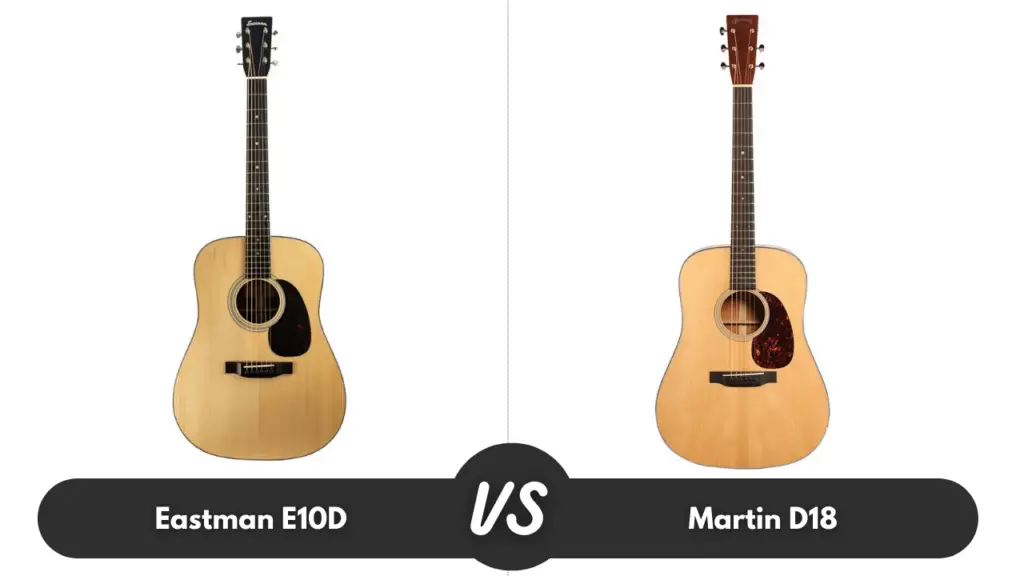The guitar has always been a popular musical instrument, and its demand has never really been in decline.
As the guitar became more popular, more and more companies began jumping on the bandwagon, manufacturing their own guitars, which has raised the bar over time. Among all the guitar brands, Eastman and Martin have held a prized position.
Both manufacturers are known for making quality guitars that have stood the test of time and have been used by thousands of guitarists all over the globe.
If you’re thinking of getting Eastman’s E10D or Martin’s D18, but don’t know what one is best for you, then this quick guide should help you make an informed decision!
| Features: | Eastman E10D | Martin D18 |
|---|---|---|
| Price: | £1100 ($1278) | £2600 ($3021) |
| Neck Material: | Mahogany | Select Hardwood |
| Body Top: | Solid Adirondack Spruce | Sitka Spruce |
| Scale Length: | 25.4 | 25.4 |
| Inlay: | Pearl Dots | Mother-of-Pearl |
| Tuners: | Open-Gear PingWell V93N 3+3 | Nickel Open Gear |
| Bracings: | Hand-Carved Scalloped X | Forward-Shifted X-Brace |
Eastman E10D Acoustic Dreadnought
Eastman is, without a doubt, one of the most popular acoustic guitar brands in the music industry. The major part of the company’s popularity originally came from their violins, as the company was originally founded as a violin manufacturer in 1992.
Since then, Eastman has dipped its toes into guitar manufacturing and has earned a sound reputation over the years.
Players expect nothing more than the best quality from Eastman, and the company has always lived up to their expectations.
Eastman’s E10D follows in from the traditional dreadnought design featuring an Adirondack spruce top along with mahogany for the sides, back and neck.
The E10D is based on the classic square shoulder dreadnoughts introduced to the mass market in the early 1930s and is still the basis of many guitar lines. Eastman seems to get it pretty much right every time.
Build
Eastman’s E10D comes with an Adirondack spruce top and mahogany back, sides and neck. Its fingerboard is ebony with a natural finish. Nothing really sets this guitar apart aesthetically, although if you’re buying a guitar with the intention of playing it, then that really shouldn’t matter.
Performance
While dreadnoughts are supposed to be loud, the open chords on the E10D were just short of spectacular in terms of volume, and the tone is great considering that the price range is around a grand. While the barre chords mightn’t be as impressive, overall, the guitar will be a surprise to most players. Eastman advertises the E10D as a “Glorious full-bodied tone and room-filling volume,” and there’s not a lot of hyperbole there. It’s basically as good as it’s advertised to be, which is a rare thing.
To some guitar players, one of the marks of a well-constructed guitar is how well the guitar harmonics resonate on the 5th fret. On the E10D, they ring loud and crisp compared to many similar guitars.
Martin D-18
Unfortunately for a lot guitarists looking for a new acoustic guitar, Martin’s D-18 can easily slip under the radar, which can lead to many missing out on an absolute gem.
At first glance, Martin‘s D-18 can be a little underwhelming. Like other Martin guitar models, it’s very much understated. But under its simple exterior is the beating heart of one of the most beautifully made and beautiful sounding acoustic guitars money can buy.
Build
Martin’s Standard Series D-18 Dreadnought Acoustic Guitar comes with a Sitka spruce top and high gloss mahogany back at sides. Martin has given the D-18 an aged finish to the spruce top. Its aged top is designed to give it a kind of retro pre-war look. For some people, this look is a hit or miss, however, it beautifully offsets the rich mahogany back and side and ebony fretboard.
The rear of the D-18 is in two pieces, although you’ll have to get out the microscope if you want to see the black pinstripe join. There’s no fancy purfling like you would see on the D-28. You get two pieces of glorious-looking wood that are joined together perfectly.
The guitar has black and antique white binding on the body, which is flawlessly executed and also does little to draw attention to itself.
Martin has added a tortoiseshell pickguard to the D-18, which helps to elevate the otherwise plain looks. The colored pickguard is another throwback to the retro pre-war era.
Under the Sikta spruce top, you’ll come across forward scalloped bracing. This is the same bracing that you find on Martin’s HD-28.
Performance
What hasn’t been lost is the D-18’s, powerful, well-balanced sound. As this is a dreadnought guitar, you automatically assume it will be loud, and Martin has assured that you won’t be disappointed.
You’ll be happy to know that Martin’s D-18 keeps an excellent midrange bump while maintaining its great bottom end without ever sounding boomy. What’s more, is it does this without the volume overwhelming its sound.
Martin’s forward scalloped bracing has increased the level of bass, volume, and projection. Additionally, there’s a noticeable increase in the amount of sustain. The D-18 feels more responsive to different levels of attack compared to similar models. When playing, it reacts quickly, producing great accuracy, to even the slightest changes in playing dynamics.
Conclusion
Both Eastman’s E10D and Martin’s D-18 are two great guitars. If you’re on a tighter budget, then you may consider Eastman’s E10D as it’s quite a bit less than the D-18.
While Eastman produces great guitars, most people consider Martin guitars to generally be superior in terms of features and sound quality, although this has made for an interesting debate recently.
